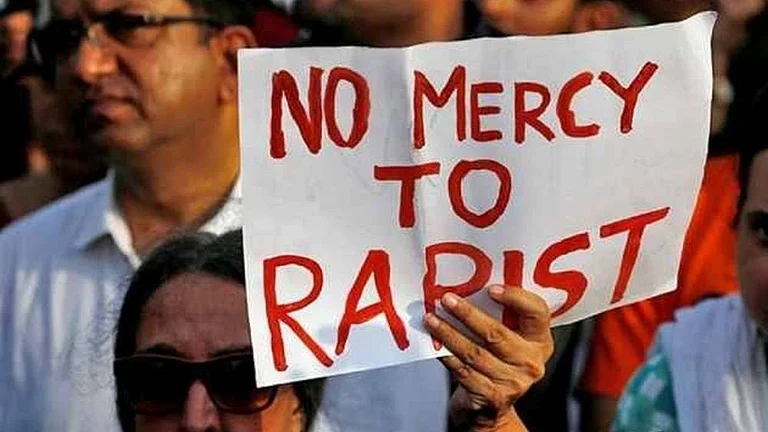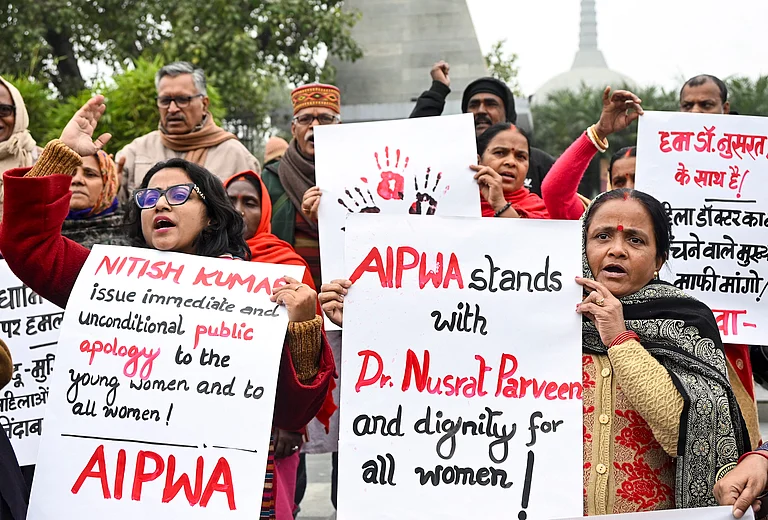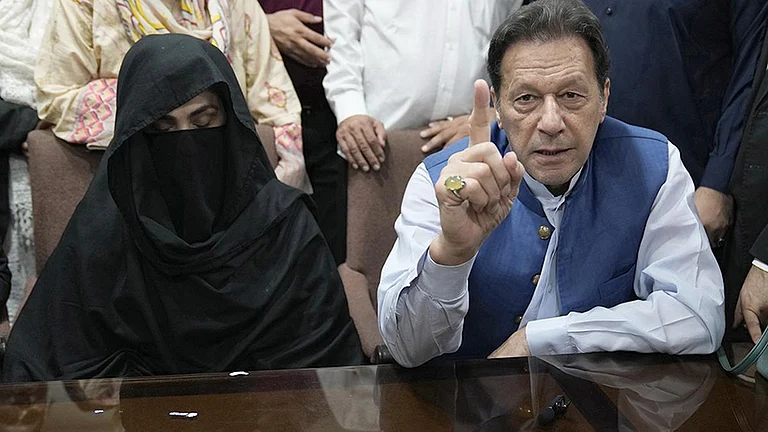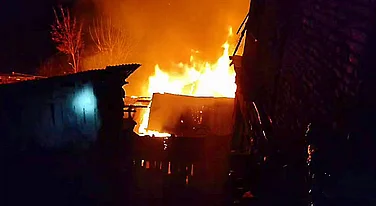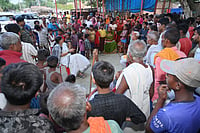It was a November afternoon last year. A crowd of about 1,000 people had gathered at Panchmah village in Gaya district of South Bihar, 30 km from Jharkhand border and surrounded by mountains.
A few villagers knocked the door of 45-year-old Arjun Das, a labourer and Mahadalit by caste. They asked him to accompany his wife, Rita Devi, 42, to the panchayat (village council).
He reached the panchayat venue alone and was shocked to see the frenzied crowd.
A 35-year-old man of normal stature, who claimed to be bhagat or ojha appeared from the crowd. A bhagat or ojha is a person who declares a woman to be a witch and claims to be an expert in exorcising evil spirits.
The self-acclaimed bhagat challenged Das “Tumhari patni dayan hain. Main isko sabit karoonga aur sabke samne nachwaunga” (Your wife is a witch. I will prove it and make her dance in front of everyone).
The bhagat was called by a local villager, Chandradev Bhuiyan, who is a Musahar, the most marginalised and stigmatised Dalit community. He believed that Das’ wife was the reason for the death of his son, Pravesh Bhuiyan.
The bhagat’s challenge to his wife was humiliating for Das but he didn’t say anything. However, he threw a condition before the bhagat could perform his rituals.
“Hum bole ki pahle bond banao ki agar humari patni ko nahi nachwa paye to tum humko pachaas hazaar rupya dega.” (I told the bhagat he should first sign a bond to pay Rs 50,000 if he is unable to make my wife dance), Arjun Das tells Outlook. The bhagat didn’t agree and fled from the scene. Das too left the crowd. But that was not the end of the case.
What happened a few minutes after this was a horrifying and barbaric act and Das still shivers while recounting it. He says, “The mob attacked my house. They looted all the jewellery and money in the house. They beat my wife and us. Then they put clothes, grains and other inflammable things on my wife’s body and set her on fire.” He somehow managed to escape, along with his two children. He has four sons, two of whom were out of station studying at the time. After that horrific incident, he left the village in fear of more attacks. He currently lives in a small rented room in Imamganj town about 6 km from his village.
This is not the first or only incident in Bihar of an atrocity on a woman after accusing her of being a witch. Last year, two women were brutally thrashed in Nawada district on the allegation of being witches. Other districts too have witnessed such cases. In 2020, Bihar reported four deaths after suspicion of witchcraft, according to the National Crime Records Bureau. The same figure was reported in 2021 as well. But overall crime cases against women in Bihar are high. In 2021, a total of 8,661 cases of kidnapping and abduction were reported from the state, highest among Indian states after Uttar Pradesh (10,574 cases).These figures show that not only in the suspicion of witchcraft but also in other crimes also women become easy victims.
There are many factors which play a role in calling a woman witch. In some cases, women are labelled witches in an attempt to seize property from them. Sometimes, jealousy against a family leading a decent life also becomes a reason for terming the woman of the family a witch. as clan members are jealous.
When a woman is branded a witch, the whole society which is illiterate and bigoted becomes her enemy and actively participates in barbaric acts against her. Terming women witches also gives society justification for violence against the woman.
In Das’ case, jealousy of a decent life was the primary reason, as he points out. “I was shifted to the Panchmah village a few years ago and got a pucca house built. I was cultivating three crops in my agricultural land. Villagers were jealous of that,” he says. But why did people kill his wife? He answers, “My wife was virtually the owner of my house. She herself was dealing with everything. Woh bahut tez tarrar thi (She was a very smart). They thought that if they destroy my wife’s character then our family will end. This is why they attacked her.”
“The irony is that despite so much progress, people still believe in witches and black magic. When a few people branded my wife a witch, the whole village took their side and blamed me. All insisted I testify that my wife was not a witch in front of the bhagat and I agreed as I knew that it was just superstition,” Das tells Outlook.
Kiran Devi, a resident of Muzaffarpur, who was attacked in 2019 on the allegation of being a witch, says, “My husband is mentally challenged and he also has paralysis. I was looking after everything, so they branded me a witch to destroy my autonomy.” She tells Outlook that it was a land dispute which resulted in an attack on her.
Bandana Sharma, who works on women’s empowerment in rural areas in Bihar believes that the roots of violence against women lie deeper. “Ever since the rajpat (kingly) system started in the world, women have become the centre of all kinds of violence. The way men treated land and other immovable things as their property, similarly women were also treated as property,” she tells Outlook. “You see, whenever there was a war between two kings, the king who won used to capture the kingdom of the defeated king along with his wives. Now the era of rajpat is no more but attacking women and considering them as property is still going on,” Sharma added.
Women in rural areas are still not able to speak out against it because they have accepted it as a part of their fate due to the oppression faced by them for centuries. “When I go to rural areas and tell women about their rights, it is very difficult to convince them. There is a fear within them that if they go to the family and talk about their rights, then violence will be done to them and the people will consider them characterless,” Sharma says. The State Women’s Rights Commision (SWRC), whose primary role is to ensure the rights of women, is almost non-functional in the state and has had no chief since 2020. It also lays bare the bitter reality of the Nitish Kumar government’s claim of working on women’s empowerment. Notably, Bihar was the first state to introduce a law against witch hunting way back in 1999. Other states followed suit. But the law is so weak that it has minimal or no impact on the ground.
According to the Act, not only is identifying a person as a witch a criminal offence but curing a woman said to be a witch by ‘jhadphook’ or ‘totka’ (rituals) and causing physical or mental harm, abetment in the identification of a witch, are all punishable. But punishment under this Act is very minimal. All offences under this Act invite a jail term of between three months and one year or a fine of Rs 1,000 to Rs 2,000. Besides, the Act does not have any provision for the rehabilitation of women victims of witch hunting.
In 2016, Raghav Lakhanpal, then a BJP MP from Uttar Pradesh, had introduced The Prevention of Witch-hunting Bill in which talks in detail about rehabilitation of women who have been branded witches. The bill says, “Due to lack of adequate rehabilitation, relief or compensation, women identified as witches return to their villages and they often face more hostility and anger from their communities with no socio-economic or property rights.” The bill is still pending with the central government.
Not only the anti-witch-hunting law but also the role of the police and the administration too have been questionable. The way police treat these cases also gives the perpetrators confidence that no action will be taken against them. In Nawada, between February to September last year, two women were branded and attacked under Rajauli Police Station but police have no knowledge of what happened to those cases. When this reporter called Darbari Chaudhary, SHO of Rajauli police station, he was surprised and claimed to be unaware of these cases. “I have no knowledge of such incidents. In villages, such things keep happening. If two families have personal issues, they call each other witches as an abuse,” he tells Outlook. “If such FIRs had been lodged, then either charge sheets were filed or they had withdrawn the complaints,” he adds. Kiran Devi has been waiting for justice since 2019. “The culprits are roaming and threatening me with dire consequences but the police are not doing much,” she says. A charge sheet is yet to be submitted in her case. Police didn’t respond to the call. In Das’ case as well, the police are yet to file a charge sheet. Das had named around 70 persons in his complaint but police have arrested just a dozen accused so far.
“It seems the police are not investigating the case properly. I have doubts that the accused have bribed the police so that the police are moving slowly,” he claims. Repeated calls to the police went unanswered. Das adds, “A local MLA had promised a government job to my son. But we are yet to get it. We have left the village. My income from agriculture has stopped. We are somehow surviving working as labourers. We need justice as well as financial stability.” As long as there is cultural sanction for the practice, the women branded witches and their families cannot hope for justice.
(This appeared in the print edition as "Culturally Sanctioned Murder")
Umesh Kumar Ray is a bihar-based independent journalist








